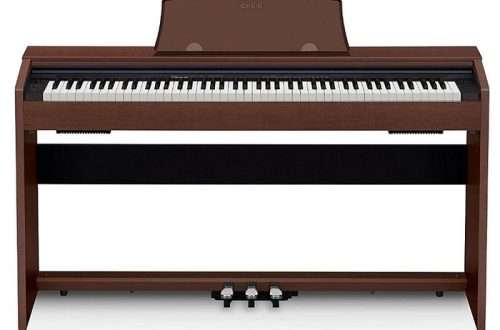Inversion of triads: how do inversions arise, types of inversions, how are they constructed?
Contents
Triad inversion is a change in the original structure of a chord in which a new related chord is formed from the same sounds. Not only triads can be addressed (a chord of three sounds), but also any other chords, as well as intervals.
The principle of inversion (or, if you prefer, rotation around) is the same in all cases: all sounds that are in a given original chord remain in their places except one – upper or lower. This upper or lower sound is mobile, it moves: the upper one down an octave, and the lower one, on the contrary, up an octave.
As you can see, the technique for performing chord inversion is the simplest. But we are mainly interested in the results of inversion of triads. So, as a result of circulation, as we have already noted, a new related chord is formed – it consists of absolutely the same sounds, but these sounds are located differently. That is, in other words, the structure of the chord changes.
Let’s look at an example:
A C major triad was given (from the sounds C, E and G), this triad consisted, as expected, of two thirds, and the extreme notes of this chord were spaced from each other by a perfect fifth. Now let’s play around with the appeals; we’ll only get two of them:
- We moved the lower sound (do) up an octave. What happened? All the sounds remained the same (the same do, mi and sol), but now the chord (mi-sol-do) no longer consists of two thirds, now it consists of a third (mi-sol) and a quart (sol-do). Where did the quart (sol-do) come from? And it came from the inversion of that fifth (C-G), which “collapsed” our original C major triad (according to the rule of inversion of intervals, fifths turn into fourths).
- Let’s turn our already “damaged” chord again: move its lower note (E) up an octave. The result is a G-do-mi chord. It consists of a quart (sol-do) and a third (do-mi). The fourth remained from the previous inversion, and the new third was built from the fact that we turned the note E around do, as a result of the sixth (mi-do), which was composed of the extreme sounds of the previous chord, was replaced by a third (do e): according to the rules of inversion intervals (and all chords, as you know, consist of some intervals), sixths turn into thirds.
What will happen if we try to reverse the last chord obtained again? Nothing special! We will, of course, move the lower G up an octave, but as a result we will get the same chord as we had at the beginning (do-mi-sol). That is, thus, it becomes clear to us that The triad has only two inversions, further attempts to convert lead us back to where we left.
What are the inversions of triads called?
The first call is called sex chord. Let me remind you that a sixth chord is made up of a third and a fourth. The sixth chord is designated by the number “6”, which is added to the letter indicating the function or type of chord, or to the Roman numeral, by which we guess at what degree the original triad was built. .
The second inversion of the triad is called quartersex chord, its structure is formed by a fourth and a third. The quartsextac chord is designated by the numbers “6” and “4”. .
Different triads give different appeals
As you probably know triads – 4 types: large (or major), small (or minor), increased and decreased. Different triads give different inversions (that is, they are the same sixth chords and quarter sex chords, only with small but significant changes in structure). Of course, this difference is reflected in the sound of the chord.
To understand the structural differences, let’s look at an example again. Here 4 types of triads from the note “D” will be constructed and for each of the four triads their inversions will be written out:
************************************************** **********************
The major triad (B53) consists of two thirds: one major (D and F sharp), the second minor (F sharp and A). His sixth chord (B6) consists of a minor third (F-sharp A) and a perfect fourth (A-D), and a quarter-sex chord (B64) consists of a perfect fourth (the same A-D) and a major third (D and F-sharp) .
************************************************** **********************
The minor triad (M53) is also formed from two thirds, only the first will be minor (re-fa), and the second will be major (fa-la). The sixth chord (M6), accordingly, begins with a major third (F-A), which is then joined by a perfect fourth (A-D). The minor quartet-sex chord (M64) consists of a perfect quartet (A-D) and a minor third (D-F).
************************************************** **********************
An augmented triad (Uv53) is obtained by adding two major thirds (1st – D and F-sharp; 2nd – F-sharp and A-sharp), a sixth chord (Uv6) is made up of a major third (F-sharp and A-sharp ) and diminished fourth (A-sharp and D). The next inversion is an increased quartersex chord (Uv64) where the fourth and third are swapped. It is curious that all inversions of an augmented triad, due to their composition, also sound like augmented triads.
************************************************** **********************
The diminished triad (Um53) consists, as you guessed, of two minor thirds (D-F – 1st; and F with A-flat – 2nd). A diminished sixth chord (Um6) is formed from a minor third (F and A-flat) and an augmented fourth (A-flat and D). Finally, the quartet-sex chord of this triad (Uv64) begins with an augmented fourth (A-flat and D), above which a minor third (D-F) is built.
************************************************** **********************
Let’s summarize our practically gained experience in several formulas:
Is it possible to build appeals from sound?
Yes, knowing the structure of any inversion, you can easily build all the chords that you learned about today from any sound. For example, let’s build from mi (without comments):
All! Thank you for attention! Good luck!



